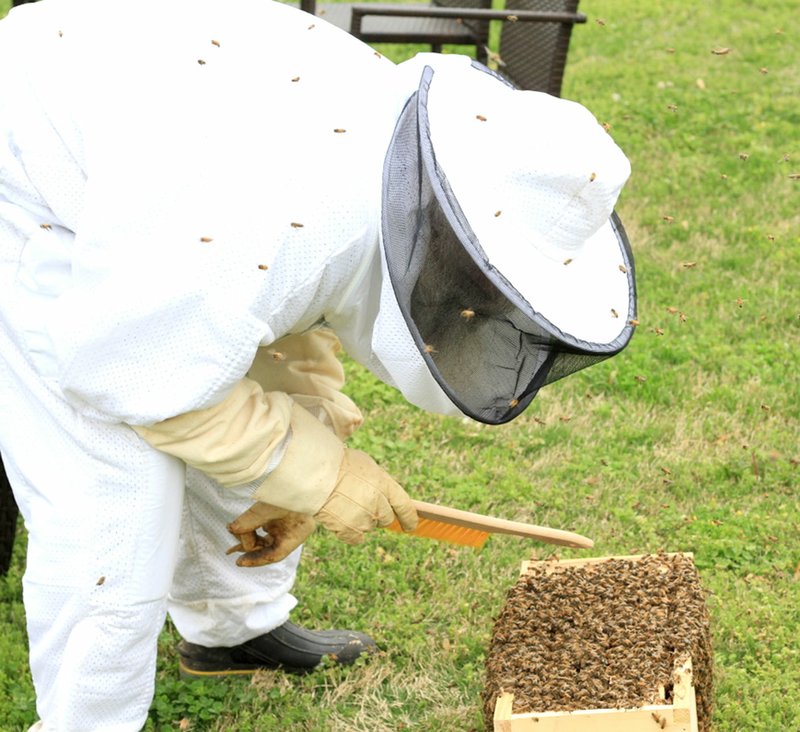GRAVETTE — Employees at Teasley Drug had some unexpected visitors when they arrived last Monday morning. A large swarm of honey bees had come in over the weekend and attached themselves to an overturned wicker lawn chair in front of the store. Jeffrey Aue, one of the young employees, discovered the swarm when he came to work.
Word soon spread of the bee invasion. After discussing how to get rid of the bees, Sandy Davis, another Teasley employee, called her husband Keith. Keith drove across the road to visit his neighbor, Marlin Spradling, a local beekeeper.
"There's a big swarm of bees up at Teasley Drug. You better go get them," Davis said.
Spradling put on his beekeeping suit, veil and gloves, loaded a bee box and drove to Teasley's to retrieve the bees. When he arrived, he placed the box on the ground, picked up the chair and gave it a good shake. Most of the bees landed on the box and started to go inside. Others fell on the seat and legs of a nearby settee and Spradling used a brush to carefully sweep them off and onto the box. Within a short time most had entered the box, with only a few stragglers flying around his head. White residue remaining on the lawn chair indicated the bees had already started to build a comb.
Spradlingapparently captured the queen bee with the first shake because the bees entered the box readily. Wherever the queen goes, the workers follow, he explained. If the workers enter the box and the queen isn't there, they may soon exit, he explained.
"And if you don't capture the queen, you're out of luck," he said. "Where she goes, they go. If she decides to light on some tires in the back of this guy's pickup, they go there. If she lights on a street sign just down the highway, that's where they go."
Spradling was surprised at the size of this bee swarm. He said he should have brought a larger box. Swarms can contain thousands to tens of thousands of bees, but this one was rather large for the area. Spradling estimated it contained nine to 10 thousand bees. He transferred them to a larger box Saturday evening.
The box Spradling first put the bees in is called a nucleus box. It is used for starting a new hive by capturing a swarm or for splitting a hive by removing a few frames of brood (developing bees) along with a queen cell and installing it in the "nuc" box, he explained. This box is smaller as the reduced number of bees have less defensive ability and cannot generate enough heat to keep a full size hive warm. The hive needs to be in the mid to upper 90s for brood to develop properly.
There were enough bees in this swarm to defend the hive and regulate the temperature. Spradling moved them into a 10 frame brood box, which is the standard size, so they are in a regular hive. He will add brood boxes or supers (where they store honey) as needed. As of Sunday afternoon, they were busily "doing bee stuff," bringing in pollen and nectar and standing guard at the entrance, he reported.
Swarming is usually a spring occurrence, commonly within a two- or three-week period depending on the locale, but occasional swarms can happen throughout the producing season. A bystander observing the bee capture reported seeing a large swarm just north of Joplin, Mo., recently. They flew right past his head when he was picking wild asparagus beside the roadway, he said.
Bee behavior is very fascinating. A little study reveals that this activity is very normal. Bee swarming is the natural means of reproduction of honey bee colonies. A new honey bee colony is formed when the queen bee leaves the colony with a large group of worker bees. In the swarm, about 60 percent of the worker bees leave the original hive location with the old queen. Secondary afterswarms sometimes happen but are usually smaller and accompanied by one or more virgin queens. Sometimes a beehive will swarm in succession until it is almost totally depleted of bees.
Worker bees create queen cups throughout the year. When the hive gets ready to swarm, the queen lays eggs into the queen cups. New queens are raised and the hive may swarm as soon as the queen cells are capped and before the new virgin queens emerge. When a swarm leaves the hive, the bees don't fly far at first. They may gather in a tree or on a branch only a short distance away. There they cluster around the queen and send 20 to 50 scout bees out to find suitable locations for a new nest.
The bees' first stop is not to make a permanent home and they will normally leave within a few hours to go to a suitable location. From this temporary location, the cluster will determine its final nest site based on the level of excitement of the dances of the scout bees. It is unusual if a swarm clusters for more than three days at an intermediate stop.
A swarm of bees sometimes frightens people, but the bees are usually not aggressive at this stage of their life cycle. This is because of the lack of a brood to defend and their interest in finding a new nesting location for their queen. This doesn't mean that bees from a swarm won't attack, but most will only do so in response to intrusions against their colony. Bees tend to swarm near their hives or honeycombs so, if a swarm is visible, a nest is nearby. They are usually not aggressive unless provoked, so it is wise to keep a good distance from the swarm.
General News on 05/04/2016

